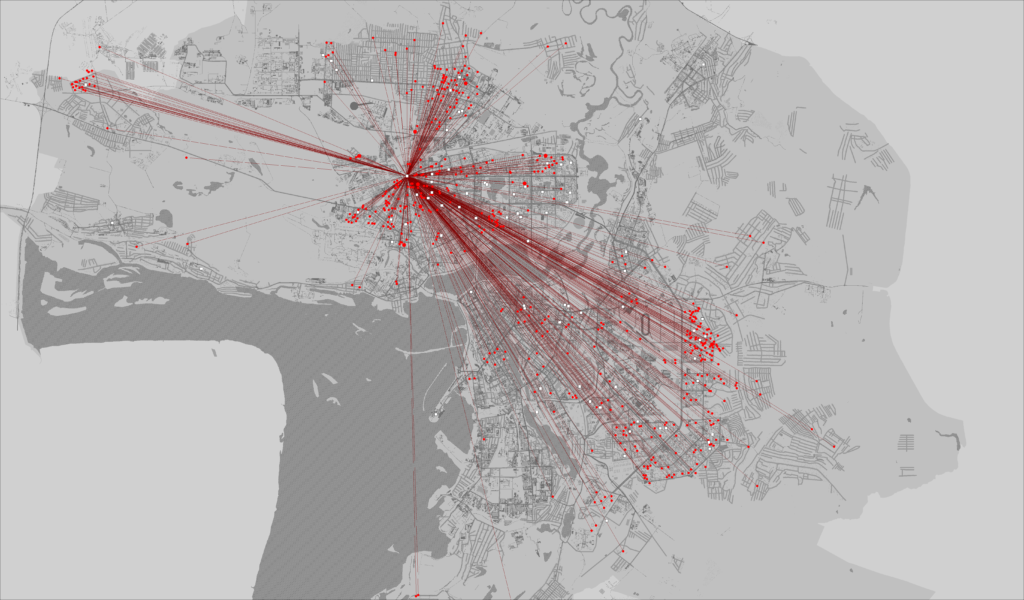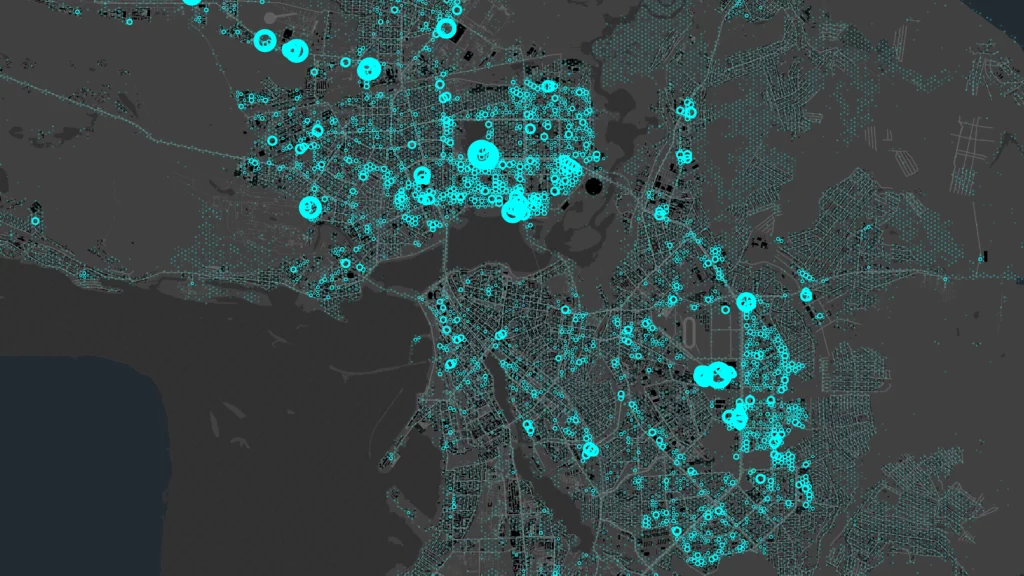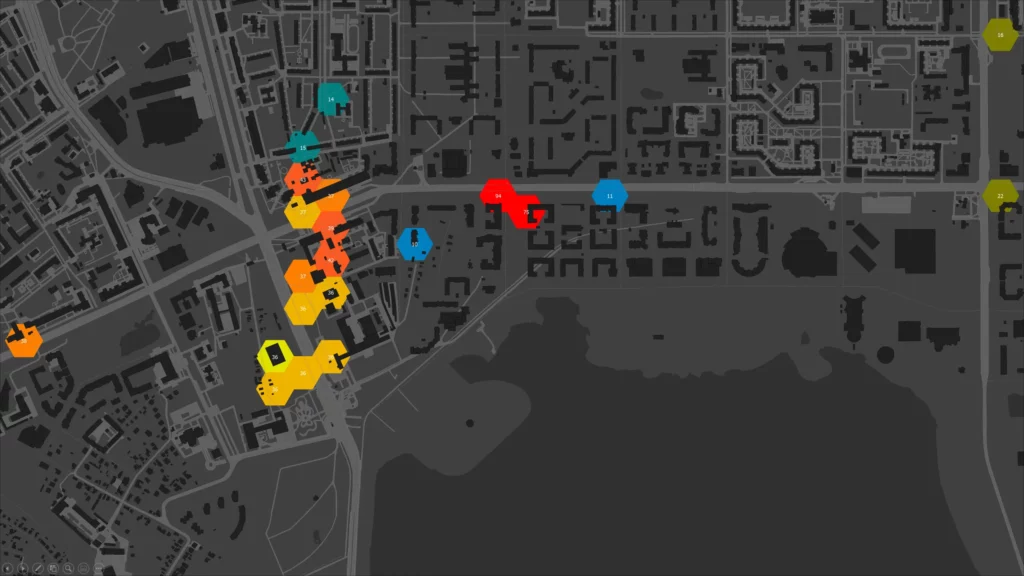Article content
The Concept was developed by the Executive Committee of Kazan in tandem with Gems development, the developer of the Geometa geoanalytical platform, to ensure the implementation of a data-driven decision support system for the development of the territory of Kazan.
The integrated municipal geoinformation system of Kazan (the System) is designed to solve the city problems associated with the processing of spatial data. The system enables 19 municipal services to be delivered digitally and automate 46 work processes.
Delivering digital public services is only part of the complex tasks of the System. The main challenge is to organize data in order to implement analytical functions, which allow the city authorities to receive up-to-date information about the city. This enables to make decisions on the necessary volumes of financing for municipal programs and city projects, which in general will increase the investment attractiveness of the city. Data-driven decision support allows to move away from subjective assessment to measurable indicators.
The concept offers options for developing the system functionality in the areas of social, public and transport infrastructure. At this point, there are 17 cases in the concept, but we’re telling about the most interesting of them.
Normative development of social infrastructure
When planning the development of the city and preparing territorial planning documents, the number and placement of educational, sports, and cultural facilities must be in accordance with the requirements of local urban planning standards: for a certain number of people within the regulatory radius of accessibility, there must be an appropriate number of schools , kindergartens, cultural, leisure and sports facilities.
Territorial planning documents are not updated more frequently than every few years. The calculation of the city’s needs for social infrastructure facilities is carried out by the urban planner at the stage of collecting initial data at the time of the start of work on adjusting the general plan. Meanwhile, the city is constantly being built and developed, plans are changing, and by the time the master plan is approved, some of the information is no longer relevant. City managers do not have tools that would allow them to see the situation “here and now” or evaluate various development options.
Objective:
To visualize the state of the territory in compliance with the local urban planning standards in terms of providing the residents with social infrastructure facilities. In addition, to visualize the results of modeling various scenarios: how will the quality of life and the load on the territory at a specific point in the city change if a residential building or a kindergarten is built there? Where will the construction bring the maximum benefit?
Implementation:
“Visualization” functionality
The tool visualizes the territory of the whole city in accordance with the local urban planning standards in different categories: education, sports, culture. For each category, the user sees on the map the number of the population and its territorial distribution, broken down into 3 groups:
- provided with urban facilities according to the local urban planning standards (that is, there are enough places in facilities within the regulatory radius of accessibility);
- partially provided (that is, there are enough places in facilities, but the regulatory radius of accessibility has been exceeded and increased travel time will be required);
- uncovered (not enough places).
The number and location of preschool institutions in accordance with the local urban planning standards, taking into account their actual workload:

“Modeling” functionality
The tool enables users to add planned social infrastructure facilities or planned residential development to the map, and the system visualizes the result of the changes.
Optimal development of social infrastructure on the example of youth policy
One of the key performance indicators for the implementation of youth policy is «Increase in the number of children involved in institutions dealing with youth affairs». To achieve the indicator, a number of basic objectives of a systemic nature needs to be addressed. The result can be achieved through a more reasonable (that is, convenient, rational and more responsive to the needs of residents) placement of institutions dealing with youth affairs, for example sport clubs, dance classes or music workshops. The decision on the need to build a new institution is made by experts. The demand for each type of club is also estimated by experts.
Objective:
To increase the effectiveness of the development of institutions by creating a tool that allows making and justifying decisions based on measurable data.
Implementation:
Functionality # 1
The tool visualizes the coverage area of each youth policy institution and each club separately. Moreover, the coverage is visualized in such a way that the real addresses where children who attend this section live are taken into account. One therefore assumes how far children live from the service (total and average distance from the place of residence to the club). And when the total distance is significantly further than similar distances for other institutions, this indicates either that the object receives a load from neighboring territories that are not provided with such a service, or that this particular club (with these particular teachers) is very popular, and people ready to visit it despite the not too convenient location.
In addition, a residential building can be examined. The system creates and demonstrates links to institutions attended by the children living in this particular residential building, and can estimate the total or average distance from the house to the clubs and display infographics for the whole city.
Coverage of all vocal and dance classes of “Teenager club”:

Functionality # 2
The objective is to provide residents with a convenient and simple service that will help them find at once all possible options for classes or clubs that the city provides, and choose the most suitable one for their children. That is, to create an open centralized database of all institutions of youth policy. Moreover, information about classes or clubs can be combined with performance metrics. For example, for the sports club, there can be information on the number of winners of various competitions, for the music workshop, the number of participants in concerts, festivals or winners of competitions; or the number of graduates of classes or clubs enrolled in universities.
Coverage of the Tasma judo club:

Transport. Traffic safety. Registration and analysis of accidents:
The goal of the municipal program «Improving Road Safety in Kazan» is to reduce the number of deaths in road accidents, compared to the same period in previous years.
Today there is no service that could visually show on the map the places of concentration of accidents, their causes, and could also provide an opportunity to compare these data with the location of road signs and traffic lights. In addition, there is no way to compare historical data, to check the effectiveness of the measures taken: whether the number of accidents decreased after the installation of a road sign or traffic light.
The better the quality of crash data, the easier it will be to find the most effective solution for each problem area in the city.
Objective:
Create a cartographic analytical service that would allow visualization of accidents, their concentrations, causes, and would also allow comparing this information with other data layers related to road safety (traffic lights, road signs, etc.).
Implementation:
Functionality #1
Information about an accident, containing all the necessary information for making decisions on road safety: type of accident, coordinates, time, severity, pedestrian participation, number of deaths, etc.
Functionality #2
Convenient data visualization that enables users to select a time interval, see the places of concentration of road accidents, infographics on the severity and harm to health, as well as the participation of pedestrians or children in road accidents.
Functionality #3
Ability to compare traffic sign data with accident data to verify that the goal of the sign installation (reducing the number of incidents in a given section) is achieved.
Places of concentration of accidents. The size of the icons is proportional to the number of accidents at a given point. The size of black symbols is proportional to the total number of injured pedestrians in a given place of concentration of an accident:

The number of accidents. When zooming in on the map, the system shows each accident. Black symbols with a number indicate the number of dead pedestrians:

Transport. Vehicle location
One of the data layers contained in the System is a digital orthophotomap. This is a photographic plan of the area, which shows the earth’s surface and objects on it with precise reference to a given coordinate system. A single coordinate space contains high-resolution images of the territory, the accuracy of which is equivalent to a topographic survey at a scale of 1:500. Today, machine vision technologies make it possible to identify and coordinate orthophotomap objects.
According to the actual data, it is possible to assess the distribution of cars across the city, places of increased density of car congestion, compare the density of the street and road network and the number of parking spaces with the actual density of car placement, and evaluate the workload of the spaces nearby residential apartment buildings.
Objective:
Create a data layer about the coordinates of each car in the city based on orthophotomap data.
Implementation:
The system has data layers with coordinates of all vehicles in accordance with orthophotomaps.
Coordinates of each car in Kazan city:

The density of cars in Kazan city:

The density of parking lots in residential apartment buildings in Kazan city:

Housing and communal services. Analysis of utility infrastructure incidents based on data from warrants for earthworks
Warrants for earthworks in connection with emergency restoration work on engineering communications are also contained in the System in the form of spatial objects with georeferencing.
The System contains data on almost 12.5 thousand issued warrants for earthworks. In its original representation, the earthworks layer does not give an adequate picture of the concentration of emergency restoration work sites on engineering communications, since the geometric dimensions of the objects differ significantly, and the places of their multiple layering are not visible to the user.
However, the data contained in the earthworks layer is sufficiently complete, regularly updated, and has a high additional potential utility for making decisions.
Objective:
Create a tool that enables visualization of data on the concentration of accidents on engineering communications based on data from warrants for earthworks.
Implementation:
Functionality #1
Identification of places of concentration of emergency restoration work on engineering communications. Places of concentration indicating the number of works:

Functionality #2
Displaying a list of organizations responsible for carrying out work on each of the places of concentration, indicating the number:

Functionality #3
Ability to select the time interval, during which the number of works is calculated and the places of concentration of works are determined.
Functionality #4
Ability to select an organization responsible for carrying out the work and build a map of work concentration areas in the context of the selected organization.
Developing functionality, accumulating data and expanding interaction with external systems, the System becomes a single source of comprehensive and up-to-date information about the territory of the city, allowing city authorities to make quick and high-quality decisions.



